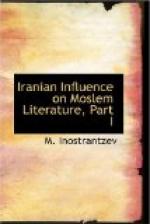The family of Naubakht, mentioned next, represents a group of scholars mentioned separately in the Fihrist.[1] The head of the Naubakhts, was an astronomer to the Khalif Mansur and his son Abu Sahl succeeded to his father’s occupation. The grandsons of Naubakht wrote books on astronomy as well as jurisprudence. Persian literary tradition is earliest recognised in the astronomical works of the grandsons of Naubakht. The author of the Fihrist places this Hasan ibn Sahl, as already indicated by Flugel, at the head of astronomers. And the same scientific character no doubt was attached to the activities of Musa and Yusuf,[2] the sons of Khalid mentioned there as well as at Tamimi, the author of the astronomical tables Zichash Shahriyar. In this manner these translators mentioned after Ibn al Mukaffa constituted in a manner a peculiar group of scholars who prepared translations from Pahlavi into Arabic.
[Footnote 1: 176, 20-177, 9; 177, 9-19; 274, 7-13; 275, 25-6. See Ibn al Kifti 165, 1-5 and 409, 3-14.]
[Footnote 2: See Ibn al Kifti, 1711, 10-11.]
Balazuri and Jabala ibn Salem have already been mentioned above. The first translated into verse a Book of the Counsels of Ardeshir and the second the Book of Rustam and Isfandiyar as well as the romance of Behram Chobin. In this way the themes handled by these writers may be called epico-historical and ethico-didactic. Purely historical questions interested the seven succeeding translators from Ishaq ibn Yazid to Mobed Behram. These persons are sufficiently known in their special departments of literature. They were the translators into the Arabic language of the Khuday Nameh.[1] Accordingly we may group them in a class by themselves.
[Footnote 1: Compare the essay of Rosen mentioned above On the question of the Arabic translations of the Khuday Nameh, 173-176, and 182-186.]
The next author mentioned at this place in the Fihrist as a translator stands by himself,—Umar ibn al Farrukhan. He is altogether unknown as a translator of historical works. Hence he was not included in the group of persons mentioned before. On the other hand, had he been set down in this passage of the Fihrist as a translator of scientific works he would have been assigned a place not at the close of the list but in the middle of the translators of this class of books, that is, after Ibn Muqaffa and in the midst of the descendants of Naubakht and other persons mentioned above. Therefore we think that Umar ibn Farrukhan was a translator of another species of work or, may be, works. In support of our assumption we must call attention to that place in the Fihrist where are enumerated the books of this author and to which an-Nadhin himself refers in the analysis of the number of translators from Persian into Arabic.




